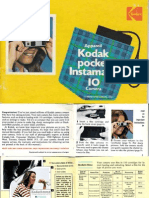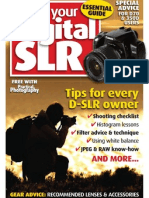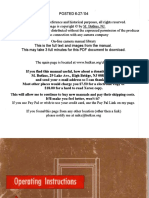10 Common Photo Mistakes
10 Common Photo Mistakes
Uploaded by
Andrei RaduCopyright:
Available Formats
10 Common Photo Mistakes
10 Common Photo Mistakes
Uploaded by
Andrei RaduCopyright
Available Formats
Share this document
Did you find this document useful?
Is this content inappropriate?
Copyright:
Available Formats
10 Common Photo Mistakes
10 Common Photo Mistakes
Uploaded by
Andrei RaduCopyright:
Available Formats
10 Common Photo Mistakes
By: Scott Bourne Everyone makes mistakes. Even Ansel Adams through some of his negatives a ay. But hat causes those mistakes! "hey are usually caused #y lack of concentration. So here$s a list of mistakes that many %hotogra%hers make. By studying them& you can avoid them. 1) Blurry Pictures Blurry %hotos are usually the result of camera shake. "he sim%lest ay to remedy this %ro#lem is to #uy and use a good& sturdy tri%od. 'f you can$t shoot ith a tri%od& remem#er to use a faster 'S( on digital cameras or faster film on film cameras. "his allo s you to increase your shutter s%eed. "he faster the shutter s%eed& the less likely you are to suffer from camera shake. A rule of thum# for handholding is to use a shutter s%eed that is 1)lens focal length or faster. 'n other ords& if you$re shooting a *00mm lens& you need 1)*00th second or faster. +on$t forget to com%ensate if you shoot digitally. 'f you use a *00mm lens on a ,ikon +100& it is the e-uivalent focal length of .00mm& so you ill need to shoot at 1) .00th of a second if you ant to handhold. 2) Contrasty Pictures "hese come from high contrast lighting situations. /earn to recogni0e them. Photogra%hing in the forest on a sunny day is an e1am%le of a high contrast situation. Photogra%hing at ,oon on a #right& sunny day is a high contrast situation. Contrast can #e mitigated ith diffusers and fill2flash& de%ending on the circumstances. 3sually the #est solution is to ait for #etter conditions. Another trick is to shoot ith lo contrast film. 4odak$s B56 Portra 700 is a good film to use in high contrast situations. 't has nine sto%s of tonal latitude and that tends to com%ress the contrast ratios in the scene. 3) Underexposed Pictures (prints) 3ndere1%osure often results from letting the camera make all the e1%osure decisions. 8emem#er& the camera$s meter ants everything to #e medium 9or gray.: 'f you do use the auto e1%osure functions& one common mistake comes from using auto e1%osure com%ensation and then forgetting you$ve done so. Make sure that you get enough light into the scene #efore you %ress the shutter. 6ith %rint film& it$s #etter to overe1%ose than undere1%ose& so hen you #racket& do it to the high side& i.e.& %lus one sto%& %lus t o sto%s. 4) Overexposed Pictures (slides) /ike undere1%osure& overe1%osure can result from letting your camera make all the decisions. 6ith slide film& overe1%osure means #lo n out highlights and that means lost information. Basing your e1%osure on shaded or dark areas and letting the camera set the e1%osure is a formula for overe1%osed slides. /ook for something medium to meter from or& #etter yet& meter the highlights. ;ust make sure your highlights on$t #e more than t o and one half 9* <=: sto%s lighter than medium. Since overe1%osing slide film is #ad& #racket your slide film to the lo side& i.e.& minus one sto%& minus t o sto%s. 5) Red Eye "his is a common %ro#lem resulting from on2camera flash. Move your flash off2 a1is. 3se a flash #racket and connecting cord. >ou can also #ounce the flash off a ceiling or all. >ou can
also use remote flash triggers to fire a flash that is mounted on a stand or any here else& as long as it is not on camera. ) !ens "lare ?lare occurs hen direct light hits the front element of the lens and light starts #ouncing around inside the lens. "his causes the light to reflect off all the elements. "his can reduce contrast and make your %ictures look @ha0y@. Most commonly& it results in a series of round highlights across your image. Be sure to use a lens hood to hel% %revent this. Sometimes you$ll need more than a lens hood. "ry using your hand or a hat to shade the lens. 'f someone is ith you& ask him or her to stand so that they cast a shado on the lens. Sometimes it$s hard to detect lens flare hen looking through the vie finderA using your de%th of field %revie #utton ill make this easier. #) O$struction Be on the lookout for intruders trying to make their ay in to your %ictures. Branches& out of focus grass #lades& tele%hone ires@B.all these and more can act as distractions. Most vie finders sho only a#out C*2CDE of the image. 4ee% that in mind hile %hotogra%hing. >ou may ant to try shifting your camera around to see hat$s at the edges. Some intruders are hard to see in the vie finder sim%ly #ecause they$re too close and not in focus. 6hen you get your %ictures #ack you see things you didn$t see #efore. 8emem#er& you$re looking through your lens at its idest a%erture& thus the shallo est de%th of field. Some things on$t #e in focus. 3se your %revie #utton and you$ll see any intruders. 'f you don$t have a %revie #utton& try focusing throughout the range of your lens to see hat may sho u%. %) &i'nettin' "his is hat ha%%ens hen items encroach on the outside edges of your camera lens$ field of vie . 't$s often caused #y stacking filters& or #y adding lens hoods to lenses that have filters attached. (ther accessories& like filter holders& can also cause vignetting. 'f your vie finder sho s less than 100E& you may not #e a#le to see this ha%%ening. 8un some tests. Put on all the different filter)hood com#inations you can think of and %hotogra%h a #lank all. "ake notes and look at your images hen you get them #ack. "he de%th of field %revie #utton ill also hel% reveal hen vignetting may #e a %ro#lem. () Color Casts Color casts can result from using the rong film& outdated or s%oiled film or shooting in dee% shade. 'f you use daylight2#alanced film like Felvia or Ektachrome Elite and shoot indoors& you could get some very strange results. 3nder tungsten lighting& regular lam% light& you$ll end u% ith a very arm color cast. 'f you$re shooting under fluorescent light& you$ll see a greenish cast. 'f the %ro#lem is the rong film& the solution is to use a color2correcting filter. ?or tungsten& use a filter in the G0 series. "hese filters are #lue and ill #alance out the yello of tungsten light. ?or fluorescent& use an ?/ filter. 'f you$re using flash indoors as your only source of light& you shouldn$t have a color2cast. "he other solution is to use the correct film. "ungsten #alanced film is made for use under tungsten lighting and ill result in the correct colors #eing recorded.
Shooting in the shade on a sunny day ill result is a #luish cast. After all& the %redominant light source is the #lue sky. 3se a filter in the G1 series. "hese yello ish filters ill #alance out the #lue. ?or outdated film@B. ell& good luck. >ou get hat you get and the only ay to correct color is after the fact& either at the la# or in the com%uter. 1)) *ilted +ori,ons (ff2center or tilted hori0ons are %ro#a#ly the most common mistake that e all make and there are several ays to -uickly solve this %ro#lem. (ur favorite is to use a focusing screen ith a grid etched into it. "hese are availa#le for many camerasA check your manual. " o cameras& the ,ikon ,G0 and the ,ikon +100& even have grid screens that you can turn on or off as a custom function. Another solution is to sim%ly ste% #ack and see if your camera looks level to the orld. "hen take another look through the vie finder. Sometimes e need to a%%roach the vie finder from an angle #ecause of the camera %osition. "aking another look through the vie finder ith your head level ill hel% too. (ne of the easiest solutions is to #uy a #u##le level for your camera. "hese levels fit in the flash hot shoe. "his ay you$ll al ays kno that you$re level. "here are times& ho ever& hen your camera may #e level #ut the hori0on ill a%%ear tilted. "his a%%arent tilting results from receding shorelinesA the closer %arts of the shoreline are lo er in the frame. ;ust #e a are of this %henomenon so you can decide if it$s something that ill #e a distraction or not. C(,C/3S'(, 6hether you are a seasoned %ro or a ne shooter& these ten %ro#lems can cree% u% on you. So revie this list often and make a mental checklist to use every time you %hotogra%h. >ou ill notice an immediate increase in the -uality of your images Article Co%yright *00D& Scott Bourne 2 Photofocus Maga0ine AB(3" "HE A3"H(8 Scott Bourne is the author of @GG Secrets to Selling 5 Pu#lishing >our Photogra%hy@ and @GG Secrets to Photosho% for Photogra%hers.@ Both are availa#le from (lym%ic Mountain School Press& htt%:)) .mountainschool%ress.com His ork has also a%%eared in #ooks& maga0ines& galleries& calendars& on greeting cards& e# sites and on %osters. Scott is a %rofessional %hotogra%her& author& teacher and %ioneer in the digital imaging field. His career started in the early I0s as a stringer covering motor s%orts for Associated Press in 'ndiana. Since then& he has shot commercial& %ortrait& edding& maga0ine and fine art assignments. His ne %assion is ildlife %hotogra%hy. Scott regularly lectures on a variety of %hoto and media2related su#Jects. He$s a%%eared on national television and radio %rograms and has ritten columns for several national maga0ines. He is the %u#lisher of Photofocus.com& an online maga0ine for serious %hotogra%hers and also serves as the e1ecutive director of the (lym%ic Mountain School of Photogra%hy in Kig Har#or& 6A.
You might also like
- Free DSLR Beginners GuideDocument18 pagesFree DSLR Beginners GuideMichael Zhang56% (18)
- Club Life Design WorkbookDocument31 pagesClub Life Design WorkbookCristiana AntunesNo ratings yet
- 22 Best Photography Cheat Sheets & InfographicsDocument30 pages22 Best Photography Cheat Sheets & InfographicsBalachandra Kuppaswamy100% (1)
- Kodak Retinette 017 ManualDocument0 pagesKodak Retinette 017 Manualஹரி ஷங்கரன்No ratings yet
- Guide To Aperture Shutter Speed and ISO PDFDocument18 pagesGuide To Aperture Shutter Speed and ISO PDFChen Vui67% (3)
- Kodak Instamatic Pocket 10 Camera ManualDocument9 pagesKodak Instamatic Pocket 10 Camera Manualrivest266No ratings yet
- VFX SuperviseDocument4 pagesVFX SupervisesravanNo ratings yet
- 44 Essential Digital Camera Tips and TricksDocument6 pages44 Essential Digital Camera Tips and TrickswellbredkannanNo ratings yet
- Tudor ArchitectureDocument7 pagesTudor Architectureapi-19307972050% (2)
- Leonardo Books PDFDocument49 pagesLeonardo Books PDFLinh Nam NguyenNo ratings yet
- Brandbook Manual de Identidade Allianz PDFDocument43 pagesBrandbook Manual de Identidade Allianz PDFPedroNo ratings yet
- Bridging The Gap Between Film and Video: 1. Use Lighting Creatively in Your ProjectDocument22 pagesBridging The Gap Between Film and Video: 1. Use Lighting Creatively in Your ProjectRahul GabdaNo ratings yet
- The Sunny 16 RuleDocument24 pagesThe Sunny 16 Ruleangulilla100% (2)
- SLR PhotographyDocument25 pagesSLR PhotographySuhas VaishnavNo ratings yet
- Photo Practical - Assgn-PpgDocument5 pagesPhoto Practical - Assgn-PpgAbid NurhafidzNo ratings yet
- Bonus Trick PhotographyDocument52 pagesBonus Trick PhotographyStefan Negoita100% (4)
- The 7 Deadly Photo MistakesDocument9 pagesThe 7 Deadly Photo MistakesHardono Dirdjosapoetro100% (1)
- 13 Tips For Improving Camera Phone PhotosDocument3 pages13 Tips For Improving Camera Phone PhotosAndrei RaduNo ratings yet
- 8 Tips For Shooting Modern Super 8 FilmDocument17 pages8 Tips For Shooting Modern Super 8 FilmPhilip BorgnesNo ratings yet
- Digital Backdrops: Quick Guide To Using BackdropsDocument5 pagesDigital Backdrops: Quick Guide To Using BackdropsAlejandro Santiago RuizNo ratings yet
- Black and White Film PhotographyDocument11 pagesBlack and White Film Photography1469No ratings yet
- House Risk AssessementDocument2 pagesHouse Risk AssessementSophieRawNo ratings yet
- 25 Digital Photography Tips For Better PicturesDocument13 pages25 Digital Photography Tips For Better PicturesSuresh Kumar MNo ratings yet
- Develop in Lightroom ExtendedDocument109 pagesDevelop in Lightroom ExtendedLamalo Edward100% (1)
- The Difference Between Film and Digital PhotographyDocument17 pagesThe Difference Between Film and Digital PhotographyelitestnNo ratings yet
- Photography Beginners GuideDocument4 pagesPhotography Beginners Guideapi-239017628No ratings yet
- Allentodd Teachingplan4Document10 pagesAllentodd Teachingplan4api-268699859No ratings yet
- Using Your Digital SLRDocument22 pagesUsing Your Digital SLRkunal_deshpande_6No ratings yet
- Short Guide To Digital Photography in ArchaeologyDocument16 pagesShort Guide To Digital Photography in ArchaeologyDavid Connolly100% (14)
- Mirror 1Document22 pagesMirror 1Sukuje JeNo ratings yet
- Camera Cleaning TipsDocument4 pagesCamera Cleaning TipsSuhas VaishnavNo ratings yet
- How To Get Consistently Great Results With MidjourneyDocument5 pagesHow To Get Consistently Great Results With MidjourneyHobbes556No ratings yet
- Photography TipsDocument31 pagesPhotography TipsNeedz R YahyaNo ratings yet
- Kodak Reflex IIDocument22 pagesKodak Reflex IINenad GrujičićNo ratings yet
- Lightin 101Document62 pagesLightin 101Nigel FarageNo ratings yet
- DigitalPhotography PDFDocument16 pagesDigitalPhotography PDFFulagnilNo ratings yet
- Tutorial - Miniature PhotographyDocument4 pagesTutorial - Miniature Photographytryanotherone915No ratings yet
- 8mm Film Tips and TechniquesDocument8 pages8mm Film Tips and Techniquesapi-3759623No ratings yet
- Macro Photography Short GuideDocument29 pagesMacro Photography Short GuideGwenetteSinclair100% (2)
- What Is Aperture?Document6 pagesWhat Is Aperture?Andrei RaduNo ratings yet
- Bored at Home?: Here Are 10 Fun Photography Ideas To Try IndoorsDocument15 pagesBored at Home?: Here Are 10 Fun Photography Ideas To Try IndoorsNieves Fillola UreñaNo ratings yet
- How To Build A 4-Mirror Stereo RigDocument9 pagesHow To Build A 4-Mirror Stereo RigSebastian CtaNo ratings yet
- Photo TipsDocument29 pagesPhoto Tipsgeschrich7No ratings yet
- Steps The: MistakesDocument6 pagesSteps The: MistakesvamcareerNo ratings yet
- Low Light and Night PhotographyDocument4 pagesLow Light and Night PhotographyMuhammad AbidNo ratings yet
- How To Take Perfect Camera ShotsDocument21 pagesHow To Take Perfect Camera ShotsVenkatesh Kandalam100% (1)
- 5 Photography Techniques Everyone Should Know: CamerasDocument5 pages5 Photography Techniques Everyone Should Know: Camerasmhk665No ratings yet
- Basic Photo Tip 285Document6 pagesBasic Photo Tip 285Malik Al-AshtarNo ratings yet
- 06 - FiltersDocument9 pages06 - FiltersAndrei RaduNo ratings yet
- Point and ShootDocument28 pagesPoint and ShootAlikatuNo ratings yet
- DSLR LensDocument19 pagesDSLR Lenstonybutcher90No ratings yet
- Decoding The Lens Jargon: Focal LengthDocument22 pagesDecoding The Lens Jargon: Focal Lengthtonybutcher90No ratings yet
- Macro PhotographyDocument8 pagesMacro Photographytshamuyarira41No ratings yet
- Convertir Una Nikon D80 en Una Camara IrDocument12 pagesConvertir Una Nikon D80 en Una Camara IrFlâneur LNo ratings yet
- Proper Exposure (Greg Benz)Document9 pagesProper Exposure (Greg Benz)Rafael ManjarrezNo ratings yet
- Focus 20Document9 pagesFocus 20awangkuafiq90No ratings yet
- Basic Flash Photography - How To - Excellent! - EbookDocument16 pagesBasic Flash Photography - How To - Excellent! - EbookTeodora AndrijanaNo ratings yet
- Digitizing 35mm Film at HomeDocument7 pagesDigitizing 35mm Film at HomeMamu Shaddi backupNo ratings yet
- Aperture, Shutter Speed, IsoDocument2 pagesAperture, Shutter Speed, IsoAndrei RaduNo ratings yet
- What Is Aperture?Document6 pagesWhat Is Aperture?Andrei RaduNo ratings yet
- 13 Tips For Improving Camera Phone PhotosDocument3 pages13 Tips For Improving Camera Phone PhotosAndrei RaduNo ratings yet
- An Introduction To Depth of FieldDocument7 pagesAn Introduction To Depth of FieldAndrei RaduNo ratings yet
- 35mm Format Camera LensesDocument6 pages35mm Format Camera LensesAndrei RaduNo ratings yet
- Apertures: (It Will Help To Have Your Camera and A Normal Lens Available While Reviewing This Lesson.)Document5 pagesApertures: (It Will Help To Have Your Camera and A Normal Lens Available While Reviewing This Lesson.)Andrei RaduNo ratings yet
- 06 - FiltersDocument9 pages06 - FiltersAndrei RaduNo ratings yet
- Realistic Rust: Select The Layer You Just Applied Lighting Effects To and ClickDocument0 pagesRealistic Rust: Select The Layer You Just Applied Lighting Effects To and ClickAndrei RaduNo ratings yet
- Goop TextDocument5 pagesGoop TextAndrei RaduNo ratings yet
- SugamSudhirBrochure PDFDocument13 pagesSugamSudhirBrochure PDFShyamal HansdaNo ratings yet
- 1978 Contemporary Art From Yugoslavia CatalogueDocument56 pages1978 Contemporary Art From Yugoslavia Cataloguedrinka100% (1)
- Terence Donovan - Speed of LightDocument3 pagesTerence Donovan - Speed of LightArtdataNo ratings yet
- Color WheelDocument1 pageColor WheelscribdhundmNo ratings yet
- Magnum Photo Story ContestDocument1 pageMagnum Photo Story ContestBrittany Hastings HillNo ratings yet
- The Decisive MomentDocument17 pagesThe Decisive MomentnanoNo ratings yet
- Course Guide - Scott WadellDocument22 pagesCourse Guide - Scott WadellPhilippe Sysmans100% (2)
- Color Model: TeacherDocument16 pagesColor Model: TeacherNikhil WadhwaniNo ratings yet
- Mil MoviesDocument2 pagesMil MoviesChicken DiNner50% (2)
- Republic of The Philippines: Department of Public Works and HighwaysDocument7 pagesRepublic of The Philippines: Department of Public Works and HighwaysMimong SamejonNo ratings yet
- World Architecture 11 Hotel Building II PDFDocument4 pagesWorld Architecture 11 Hotel Building II PDFBALRAMNo ratings yet
- POP & Painting ChecklistDocument2 pagesPOP & Painting ChecklistKishore Yla67% (3)
- PuzzlesDocument11 pagesPuzzlesPratim MajumderNo ratings yet
- Architects in PondicherryDocument3 pagesArchitects in PondicherrymohanNo ratings yet
- #3024 - ENGLISH Dresses: Short Kimono Sleeve Boat Neck With Hidden BindingDocument6 pages#3024 - ENGLISH Dresses: Short Kimono Sleeve Boat Neck With Hidden BindingSamuel David ZambranoNo ratings yet
- Chennai - Weather Data AnalysisDocument23 pagesChennai - Weather Data AnalysissajithNo ratings yet
- Arts ND Crafts Movement-Chicago-Reliance-Art NoveuDocument45 pagesArts ND Crafts Movement-Chicago-Reliance-Art Noveusteen cahillNo ratings yet
- LECTURE - 03-Relationship of Structure To Architectural Buildings Part IIDocument32 pagesLECTURE - 03-Relationship of Structure To Architectural Buildings Part IIMADHU MITHANo ratings yet
- Digital Printmaking: Pixels, Dots, and Ink JetsDocument9 pagesDigital Printmaking: Pixels, Dots, and Ink JetssoujanaNo ratings yet
- Extreme How-To Magazine - April 2014 PDFDocument92 pagesExtreme How-To Magazine - April 2014 PDFAndre nichols100% (1)
- Drinking - Punch Bowls - European & ChineseDocument42 pagesDrinking - Punch Bowls - European & ChineseThe 18th Century Material Culture Resource Center100% (1)
- PointingDocument4 pagesPointingNaresh Yadav100% (4)
- Boysen Flat Latex Finish PDFDocument7 pagesBoysen Flat Latex Finish PDFJohn Rhey Lofranco TagalogNo ratings yet
- Framing Effective Shots: Screen Size and Field of ViewDocument11 pagesFraming Effective Shots: Screen Size and Field of Viewandrei neagNo ratings yet
- Squirrel in A Tree: Carving Project - Pattern Provided in Pullout SectionDocument11 pagesSquirrel in A Tree: Carving Project - Pattern Provided in Pullout SectiondonguieNo ratings yet
- WallSystems PDFDocument26 pagesWallSystems PDFEiz Zu DeenNo ratings yet
- Leisure Painter December 2017Document80 pagesLeisure Painter December 2017JuanRodriguez100% (2)































































































